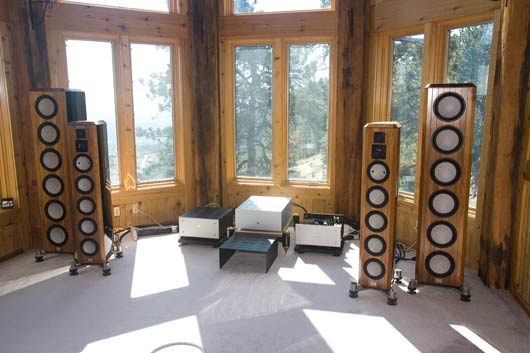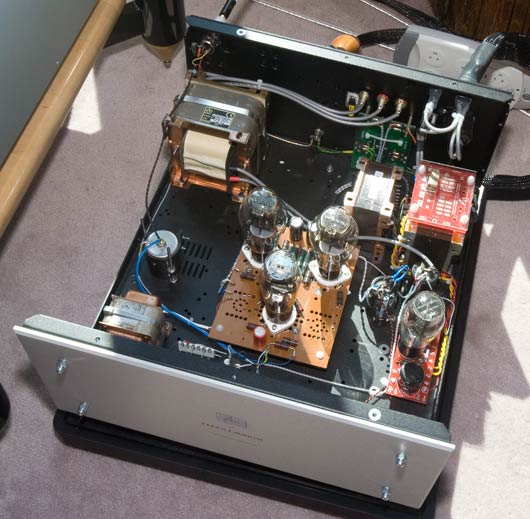Quick Tour





The inside of one of the Audio Note Kegon Balance 300B amplifiers. The Kegon Balance is essentially a 300B Gaku-on. The Gaku-on is Audio Note’s best amplifier which is based on the 211 tube.
The sound?
Very dynamic and controlled. The signature reticence of the speaker’s ceramic drivers is no longer audible. It is hard to over-state this aspect of these amps. A lot of the time is just spent thinking ‘I didn’t know amps could DO that’.
In comparison, solid-state amps just smack the notes out with a sledge-hammer – they [currently seem to] have no ability to control the shape of the notes as it they are supposed to be – if they are to sound like music [or even just musical] that is.
And in comparison, most tube amps just sound anemic, where they, overall, can generated notes shaped more naturally, more real, than solid-state, but lack that SMACK that most musicians often apply to their piano or guitar or drum.
Just the right amount of harmonics. Which is to say more than the Lamm ML2.1 6C33C tube-based amplifier, and less than your other 300B-based amplifiers [that we have heard]. Presumably all of our readers know how bad too little harmonics affects the enjoyability of music. And for too much harmonics, too much harmonics and the primary tone washes out the lesser tones – and it is the lessor tones that make a person hear deep into the richness and playfulness and… I don’t know – that thing that happens when you go into a toy store and bang on some chimes – or into a Tibetan store [we have a dozen here in Boulder] and bang on the gongs or use the Bhuddist bowls – or to a piano store and bang on the keys of their best piano — JUST to listen to the sound and the undertones [and the lovely decades-long decay].
Anyway – more on this system after RMAF.

Sorry, you didn’t win the Dar ES Salam lottery.
I have lurked around your pages reading your impressions of AN equipment. Now, I was particularly interested in comparison between the Conquest monoblocks and the Ongaku. Fine. The Conquest costs about 1/4 as much, give or take, as the Ongaku. So, It sounded “thin”. Now along comes the P-4 balanced monos, which looks awfully like the Kegon Balanced 300B monos, and also costs between 1/4-1/3 of the Kegons. The only really visible difference between the two is the driver tube.
So, how does the P-4 sound in relation to the Old Kegons?
Hi Mac,
Sorry you didn’t win it either.
Or… did… you? 🙂
The short answer is we haven’t heard the P-4 here. There are also 4 different models to choose from.
The Conquests are 300B-tube based and the Ongaku 211-tube based – so there is a large difference there. The Ongaku grips a speaker better than any amp we have heard, by a large margin, until we heard the Kegon Balanced.
I would guess that the P-4 Balanced is to the Kegon Balanced as is the Conquest is to the old Kegon. That would be that the higher level amp can control the speaker much better, has more resolution, and has more control over the harmonics [more shades of color] while sounding a little more neutral at the same time.
Hope that helps.
Maybe the next lottery….
Take care,
Mike.
I have heard both the current (I think) Conquest and the Kegon monos, but not the P-4s. I have never seen the insides of either the Conquest or the Kegon either, but they look “almost” identical. However, they certainly sound different in just the way you describe. I wonder what the P-4 adds.
In fact, I dare say the Conquests sound a bit clinical and non-involving, even if they have better range, more detail and greater balance than the bottom of the AN line. Perhaps the OTO sounds deceptively more engaging than it is, but its ability to portray music “feels” to me closer to the top of the AN range than the middle.